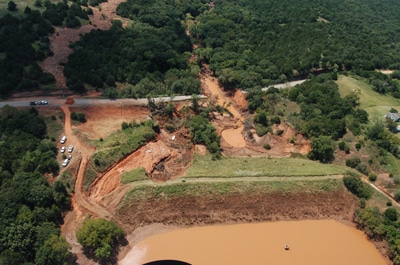Conservation Leaders Applaud U.S. Sec. of Ag Stimulus Announcement for Oklahoma Flood Control Dams

Oklahoma conservation leaders reacted positively to U.S. Sec. of Agriculture Tom Vilsack’s announcement on Monday, April 6, about funding coming to the state to rehabilitate flood control dams. Vilsack announced funds from the American Recovery and Reinvestment Act (ARRA) going to 11 states for rehabilitation of flood control dams. Of the $45 million going to projects nationwide, just over $14 million, or over 30 percent, is coming to Oklahoma. Seven dams in four counties and three congressional districts are slated for funding.
Cottonwood Creek 15 in Kingfisher County will receive $3,610,000 in federal funds. Sallisaw Creek 18 in Adair County will receive $4,160,000. Upper Clear Boggy Creek 33, 34 and 35 in Pontotoc County will receive $1,010,000, $960,000 and $840,000 respectively. Washita–Sugar Creek L-43 and L-44, both in Caddo County, will receive $1,645,000 and $1,790,000 respectively. The Kingfisher Creek site and both Washita-Sugar Creek sites are in U.S. Rep. Frank Lucas’s 3rd Congressional District. The Sallisaw Creek site is in U.S. Rep. Dan Boren’s 2nd District. And the Upper Clear Boggy sites are in Rep. Tom Cole’s 4th District.
OACD President Trey Lam said this investment in conservation has been well received in
Oklahoma. “We are excited that these funds are coming to our state,” Lam said. “Clearly the need is there and these dollars will definitely help address critical needs in the countryside.”
The dollars are to be received by the USDA’s Natural Resources Conservation Service (NRCS) in Oklahoma as part of the stimulus funding being distributed nationally. The funding is for rehabilitation of upstream flood control structures with the goal of creating new jobs while repairing critical infrastructure.
The need for rehabilitation is caused by different factors in different locations. In Oklahoma, stimulus funds for rehabilitating flood control structures will go to projects where the greatest risk of structure failure and threat to life and property exist. The Sugar Creek sites were severely damaged when Tropical Storm Erin moved inland across Texas and western Oklahoma in August 2007. In other locations, like Upper Clear Boggy 33, the dam was built as a low hazard dam protecting only agricultural land. The construction of homes and county roads in the downstream breach inundation area have caused the reclassification as high hazard and created the need for rehabilitation.
“I am pleased that Oklahoma will receive $14 million of the $45 million funded nationwide,” said Ron Hilliard, state conservationist in Oklahoma for NRCS. “That is nearly a third of the total program funding and will go to rehabilitate seven high priority dams in the state,” he said.
“Oklahoma has 2,105 upstream flood control structures, more than any other state,” Lam said. “We
are pleased that the President and Congress have appropriated this stimulus money to rehabilitate some of these structures. As our flood control infrastructure ages, we literally are in a race against time when it comes to our ability to continue protecting people and property from flooding. These funds will be put to good use.”
It is anticipated that approximately 170 additional local jobs will be created by this rehabilitation work that will be put out for bid by private construction contractors. In addition, dollars will be spent with local businesses for supplies and services associated with the projects. Rehabilitation funds for the flood control structures will also require state and local match.
According to Mike Thralls, executive director of the Oklahoma Conservation Commission, the match required from the state of Oklahoma for these funds is in legislation currently at the Capitol. Senate Bill 238 authorizes a bond issue for $25 million that includes funds to make up the state’s required 35 percent construction cost match to receive the federal funds.
“Authorization of the Conservation Bond would insure we have the resources necessary to capture these federal funds as well as do additional repair to damaged conservation infrastructure caused by the floods of 2007. It would be a shame if Oklahoma had to turn back these federal funds for critical infrastructure repair.”
Clay Pope, OACD executive director agreed.
“Oklahoma has been a national leader in flood control dam rehabilitation,” Pope said. “Now the folks in Washington D.C. have recognized the critical need we have when it comes to protecting the lives and property of our citizens. We are extremely grateful to the Obama Administration and to the Congress for ensuring that these funds are available to the states We are confident that the Oklahoma Legislature and the Governor will once again answer the call and reauthorize the Conservation Bond so that we can match these dollars, hire some folks in rural Oklahoma and get started addressing the damage caused by the storms of 2007.”
Later in the afternoon on Monday, April 6, the Oklahoma House of Representatives’ Appropriation and Budget Committee approved legislation that could help provide state match for the federal funds. By a vote of 15 to 1, the committee approved Senate Bill 238 that authorizes a bond issue to provide $25 million for conservation projects in the state. Part of the money will be used to provide the state’s required 35 percent match for the federal construction funds for dam rehabilitation if the bill becomes law. SB 238 next goes to a vote in the full House of Representatives. If it passes there, it will back to the Senate for approval.
The Sallisaw Creek Dam No. 18 and the Sugar Creek Dam No. L-43 would most likely be the first to begin, according to the Conservation Commission, with contracts possibly being put out for bid as early as June 2009.
Additional information, as it becomes available, will be posted on www.conservation.ok.gov, www.oacd.us, www.ok.nrcs.usda.gov, www.recovery.ok.gov, www.usda.gov, and www.recovery.gov.
